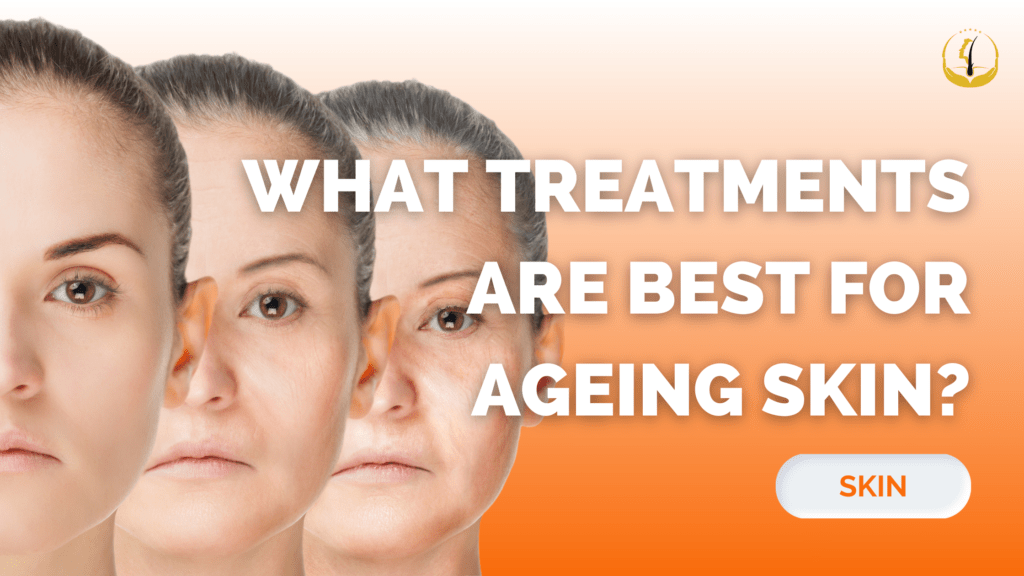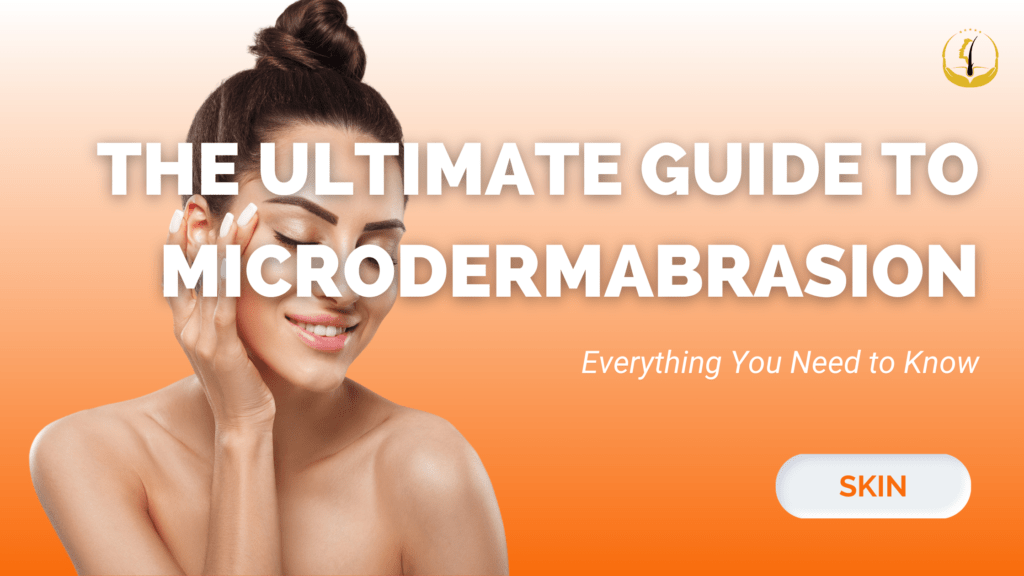What Are The Best Treatments for Aging Skin?

As we gracefully journey through life, our skin undergoes natural changes that reflect the passing years. The ageing process brings with it a host of transformations, from fine lines and wrinkles to reduced elasticity and uneven skin tone. However, thanks to the advancements in aesthetic treatments, we can now choose from an array of options to help restore youthful radiance and maintain our skin’s vitality. Keep reading to find out the best options available for ageing skin. 1. Botox Injections Botox injections have gained immense popularity as a quick and effective solution for tackling wrinkles and fine lines. Comprising botulinum toxin, these injections work by relaxing the muscles that cause these lines to form. This treatment is particularly effective for addressing forehead lines, crow’s feet, and frown lines. Botox injections are minimally invasive and offer results that can last for several months, making them a preferred choice for many individuals seeking a smoother complexion. 2. Dermal Fillers Dermal fillers are another popular option to combat the signs of ageing. These injectable treatments are designed to restore lost volume, plump up sagging skin, and smooth out wrinkles. Hyaluronic acid fillers, such as Juvéderm and Restylane, are commonly used to achieve natural-looking results. Dermal fillers can target various areas, including nasolabial folds, marionette lines, and even enhance lip volume. The effects typically last several months to a year, depending on the specific filler used. 3. Chemical Peels For those seeking a more comprehensive skin rejuvenation, chemical peels offer a promising solution. These treatments involve applying a chemical solution to the skin, which exfoliates the outer layer, revealing fresher and more youthful skin underneath. Chemical peels can improve skin texture, reduce fine lines, and address issues like hyperpigmentation and sun damage. The strength of the peel can be adjusted based on individual needs, with mild peels requiring little downtime and deeper peels offering more significant results. 4. Laser Therapy Laser treatments have revolutionized the field of aesthetic dermatology, offering a wide range of options to address ageing skin concerns. Fractional laser resurfacing is a popular choice, as it stimulates collagen production, tightens the skin, and reduces the appearance of wrinkles and scars. Intense Pulsed Light (IPL) therapy is another laser-based technique that targets pigmentation irregularities and improves skin tone. It’s important to note that multiple sessions might be required for optimal results. 5. Microneedling Microneedling, also known as collagen induction therapy, involves using tiny needles to create controlled micro-injuries in the skin. This process stimulates the body’s natural collagen production, leading to firmer, smoother skin over time. Microneedling is effective for treating fine lines, wrinkles, acne scars, and even stretch marks. Some practitioners combine microneedling with the application of serums or platelet-rich plasma (PRP) to enhance results. 6. HIFU High-Intensity Focused Ultrasound (HIFU) is a non-invasive treatment gaining popularity in the realm of anti-ageing. This advanced procedure utilizes focused ultrasound energy to penetrate deep layers of the skin, stimulating collagen production and resulting in firmer, tighter, and more youthful-looking skin. HIFU targets specific areas, such as the face, neck, and décolletage, offering visible improvements in skin laxity and reducing the appearance of wrinkles. With minimal discomfort and no downtime, HIFU provides a convenient option for individuals seeking a non-surgical approach to rejuvenating their skin and achieving a more vibrant and radiant complexion. Ageing is a natural part of life, and while it brings about changes in our skin, it doesn’t mean we have to relinquish our desire for healthy and vibrant skin. Aesthetic treatments offer an array of options to address the signs of ageing, from wrinkle-smoothing Botox injections to skin-plumping dermal fillers, revitalizing chemical peels, advanced laser therapies, and collagen-boosting microneedling. Each of these treatments comes with its own set of benefits and considerations, so consulting with GLOJAS skin experts is essential to determine the best approach for your individual needs. Click the link to learn more about Ageing Skin: “HIFU treatment as the Anti-Ageing agent” At Glojas, we welcome clients to reach out to us directly to schedule a free initial consultation. We offer guidance and valuable insights on how best to address your specific challenges. Let us assist you in navigating your journey with confidence and clarity.
The Ultimate Guide to Microdermabrasion: Everything You Need to Know

Microdermabrasion stands as a remarkable skin treatment, wielding the power to erase signs of aging and unveil a youthful, fresh complexion. This guide unravels the intricacies of Microdermabrasion, exploring its origins, benefits, safety, and what to expect from this transformative skin procedure. Microdermabrasion: A Historical Glimpse Origin in 1985 in Italy: Microdermabrasion emerged as a skin treatment in Italy in 1985. With over 100 machines available, they share a fundamental purpose – peeling and extracting dead skin cells. The Transformative Effects Combating Wrinkles, Fine Lines, and Acne Scars: Microdermabrasion has demonstrated effectiveness in reducing wrinkles, fine lines, and acne scars. While results may vary, those with enlarged pores can also rejoice as the treatment aids in minimizing their size. Addressing Superficial Skin Damage: This procedure proves beneficial in diminishing age spots, superficial hyperpigmentation, and sun-induced skin damage. By removing dead skin, Microdermabrasion enhances the penetration of skincare products and facilitates smoother makeup application. Why Choose Microdermabrasion? Safe and Affordable Alternative: Many opt for Microdermabrasion over chemical peels and laser treatments due to its general safety and affordability. While some discomfort may be felt during the procedure, it is generally well-tolerated and doesn’t cause significant pain, irritation, or harm. Stimulating Blood Flow: Microdermabrasion stimulates blood flow, increasing nutrient delivery to skin cells. This boost in cell production enhances skin texture and elasticity. Temporary moisture removal during the process allows for better absorption of high-quality moisturizers. Considerations and Caution Ideal Candidates: Individuals between 30 to 55 often witness the best results with Microdermabrasion. However, those with certain skin conditions like eczema, sunburn, rosacea, dermatitis, psoriasis, severe acne, lupus, herpes, open sores, or fragile capillaries should avoid this treatment. What to Avoid Beware of Ready-made Kits: Ready-made Microdermabrasion kits available in the market may pose risks to your skin. It’s crucial to exercise caution and refrain from using such products. Optimal Session Frequency: Completing 5 to 10 sessions is typically recommended for the best results. The skin usually recovers within 2 weeks, showcasing the transformative effects of the treatment. The Treatment Process Duration of Sessions: A typical session lasts around 30 minutes for the face, with longer durations if treating additional areas like the neck, hands, or feet. Post-Treatment Care: Sensitivity post-treatment is common, necessitating sun avoidance and immediate application of sunscreen lotion. To unlock the full spectrum of benefits that Microdermabrasion offers, seek the expertise of renowned cosmetic clinics such as GLOJAS. With experienced surgeons and personalized consultations, GLOJAS Clinic ensures a journey towards remarkable skin transformation. Avail yourself of a FREE consultation at GLOJAS Clinic to embark on your path to rejuvenated and radiant skin.
Can Sunburn Cause Hyperpigmentation?

Basking in the warm embrace of the sun is a delightful experience, but it comes with risks, especially when prolonged exposure leads to sunburn. What many may not realize is that severe sunburn can result in an undesirable outcome—hyperpigmentation. This article delves into the connection between sunburn and hyperpigmentation, shedding light on two effective treatments: fractional laser and MedLite. Sunburn and Hyperpigmentation Sunburn, a consequence of excessive exposure to ultraviolet (UV) rays, particularly UVB rays, manifests as red, painful, and sensitive skin. Beyond the immediate discomfort, the skin responds to UV damage by increasing melanin production, the pigment responsible for skin color. While a natural defense mechanism, this response can sometimes cause uneven melanin distribution, leading to hyperpigmentation. Hyperpigmentation presents as darkened patches on the skin, taking forms such as freckles, age spots, or larger areas. Post-inflammatory hyperpigmentation (PIH) is a common result of sunburn, triggered by the skin’s inflammatory response. Individuals with darker skin tones are more susceptible to developing hyperpigmentation after sunburn. Treatment Options: Fractional Laser and MedLite 1. Fractional Laser Treatment Fractional laser treatment emerges as a groundbreaking solution for various skin concerns, including hyperpigmentation. This procedure employs a laser to deliver precise microbeams of energy into the skin. These microbeams create controlled injuries in the deeper layers of the skin, initiating the body’s natural healing process and encouraging the production of new, healthy skin cells. In addressing sunburn-induced hyperpigmentation, fractional laser treatment targets excessive melanin in affected areas. The laser energy breaks down melanin particles, enabling the body to gradually eliminate them. Over multiple sessions, hyperpigmented patches fade, restoring a more even skin tone. 2. MedLite Laser Treatment MedLite laser treatment stands out as another effective option for managing hyperpigmentation resulting from sunburn. Emitting high-intensity pulses of light, the MedLite laser specifically targets melanin within the skin. This targeted energy breaks down excess melanin, allowing the body’s immune system to naturally eliminate it. Known for its precision, MedLite treatment selectively targets pigmented areas while sparing the surrounding skin. This makes it suitable for individuals with all skin types and tones. Like fractional laser treatment, optimal results may require multiple MedLite sessions. While the sun’s rays offer relaxation, unprotected and excessive sun exposure can lead to sunburn and severe consequences such as hyperpigmentation. Increased melanin production in response to sunburn results in uneven skin tone and darkened patches. Fortunately, advanced treatments like fractional laser and MedLite offer effective solutions for sunburn-induced hyperpigmentation. It is imperative to consult with a qualified dermatologist or skincare professional before undergoing any treatment. Their assessment of your specific skin type and hyperpigmentation severity will guide the most appropriate treatment plan. Additionally, adopting preventive measures like broad-spectrum sunscreen use, protective clothing, and seeking shade can minimize the risk of sunburn and subsequent hyperpigmentation, ensuring the enjoyment of the sun safely.
The Ultimate Guide to Prolonging the Benefits of Cosmetic Procedures

Cosmetic surgery is often seen as an investment in one’s appearance, contributing to increased confidence and satisfaction. While these procedures yield high patient satisfaction rates, it’s crucial to recognize that ongoing care and maintenance are essential to preserve results amidst the inevitable impacts of aging, lifestyle choices, and genetics. This guide explores key strategies to enhance and sustain the outcomes of your cosmetic surgery. A Diet And General Exercise Are Vital Understanding the Impact of Weight: Cosmetic surgery, particularly procedures like breast enlargement or liposuction, can sculpt your body contours for a more appealing look. However, maintaining a healthy weight is crucial for preserving these outcomes. Permanent fat cell removal through liposuction, for instance, can be undermined by weight gain in other areas. Stability After Lifting Procedures: For individuals undergoing lifting procedures such as breast lift or tummy tuck, it’s essential to maintain a stable weight range. Fluctuations in weight can compromise the integrity of the surgical results. Great Skin Care Has A Major Effect Now And Later Immediate Post-Surgery Care: Proper care immediately after cosmetic surgery significantly impacts scarring. Adhering to post-operative skincare routines aids in optimal healing and minimizes scarring. This is particularly relevant for facial procedures like Dermal Fillers. Long-Term Impact of Skincare: Long-term use of prescribed skincare products plays a pivotal role in the sustained success of cosmetic surgery results. Physicians often provide comprehensive guidance to patients, ensuring the use of appropriate products for continued skin health. Healthy Habits Pre and Post-Surgery Lifestyle Choices: Cosmetic surgeons commonly advise patients to abstain from tobacco and alcohol both before and after surgery. These substances can impair the body’s healing capabilities, leading to extended recovery times and potential complications such as pain, bleeding, and noticeable scarring. Ongoing Lifestyle Choices: Avoiding alcohol and tobacco is not just a pre and post-surgery requirement but a commitment to ongoing well-being. These substances can continue to impact your health, potentially undermining the long-term success of cosmetic surgery. In conclusion, while cosmetic surgery delivers transformative results, the responsibility lies with the individual to maintain these outcomes. A healthy lifestyle, consistent skincare, and adherence to post-operative guidelines contribute significantly to the prolonged success of cosmetic procedures. For personalized advice and information, GLOJAS Clinic offers FREE consultations, guiding individuals on the journey of maintaining and enhancing their cosmetic surgery results.
Expert Advice: What to Do When You Experience Bad Dermal Filler Results

Dermal filler injections are a popular choice for addressing wrinkles, fine lines, and restoring volume to aging skin without the need for surgery. Unfortunately, some individuals experience disappointing results due to visiting inexperienced practitioners. The good news is that even if you’re dissatisfied with your dermal filler outcomes, an experienced cosmetic surgeon can often make improvements. This article provides expert advice on dealing with bad dermal filler results. Massage At The Treated Area Why Massage: Issues like lumps or asymmetry can be improved through proper massage techniques in the treated area. Seeking guidance from a skilled surgeon ensures that the massage is performed correctly, and they can teach you the appropriate method for continued care. Process To Expel Juvéderm And Other Fillers Introduction to Hyaluronidase: Hyaluronic acid fillers, including Juvéderm, Belotero, and Restylane, can be partially or completely reversed using an enzyme called hyaluronidase. This enzyme dissolves hyaluronic acid particles, addressing issues such as infection, excess swelling, disappointing results, irregular texture, and vascular compromise. Considerations: It’s essential to be aware that while hyaluronidase is effective, it may remove more filler than necessary, requiring additional treatment to achieve your aesthetic goals. Additionally, individuals with allergies to animal-derived products may not be suitable candidates for this treatment. Despite these considerations, hyaluronidase can often save patients from prolonged discomfort resulting from poorly performed filler injections. What To Do Next Temporary Nature of Dermal Fillers: Remember that dermal fillers are temporary, and time is often the best solution for addressing undesirable outcomes. Over time, your body naturally metabolizes the filler, allowing for a fresh start if desired. Immediate Concerns: If you’re experiencing pain, irregular swelling, or the treated skin feels warm to the touch, it’s crucial to consult with a qualified cosmetic surgeon promptly. These could be signs of infection that require immediate attention. GLOJAS Clinic offers FREE consultations for individuals seeking expert advice on their dermal filler concerns. In conclusion, bad dermal filler results can be disheartening, but with the right approach and guidance from an experienced cosmetic surgeon, improvements are often possible. Time, correct massage techniques, and, in some cases, the use of hyaluronidase contribute to achieving optimal results. If you’re facing challenges with your dermal filler outcomes, don’t hesitate to consult with the professionals at GLOJAS Clinic for personalized and expert advice.
Flawless Skin Secrets: Proven Acne Prevention Tips for a Clear Complexion

Maintaining flawless skin can be a challenge, especially in hot and humid conditions like those prevalent in Malaysia. These environmental factors contribute to the growth of acne and other skin issues. In this guide, we’ll explore proven acne prevention tips that can help you achieve a clear complexion, even in the humid weather of Kuala Lumpur (KL). The Impact of KL’s Climate on Skin KL, renowned for its tourist attractions and vibrant nightlife, is equally notorious for its hot and humid climate—a significant factor in the prevalence of acne and various skin conditions. With more than 75% of teenagers and many adults grappling with acne-related issues, it’s crucial to adopt skincare and lifestyle changes to combat these challenges and keep pimples at bay. Wash Your Face: A Fundamental Step Why: Developing a routine of washing your face after sweating, especially in hot and muggy conditions, is essential. This practice removes accumulated oil and dirt particles, preventing pore clogging. How: Use an alcohol-free, non-abrasive skin wash. Rinse with warm water to open pores, but avoid excessively hot water, which can strip away skin moisture. Expel the Oil: Combating Excess Oil Production Hot and humid conditions stimulate excess oil production in the skin’s pores, worsening skin conditions and triggering acne. Using salicylic acid or benzoyl peroxide, common ingredients in anti-acne medications, helps dry up excess oil and combats acne-causing bacteria. Refrain From Touching: Minimizing Bacteria Spread Excessive touching spreads oil, dirt, and bacteria, aggravating acne. Instead of touching, blot your skin with a soft, clean tissue during high humidity. Oil-absorbing blotting papers are also effective in removing excess oil and sweat, enhancing your skin’s appearance. Forget About the T-Zone: Targeted Moisturizing In humid conditions, avoid applying moisturizer to the T-zone—the oily areas covering your nose and forehead. Opt for an oil-free moisturizer for the remaining skin to prevent pore blockage and acne formation. Remember, excessive touching can lead to acne scars. If you already have acne scars, seeking professional acne scar treatment, such as those offered at GLOJAS Specialist Clinic, can contribute to achieving flawless and youthful skin. Consult for FREE at GLOJAS to discover personalized acne treatment and additional skincare tips tailored to your unique needs.
Botox for Sweaty Skin: How Does It Work?

Cosmetic surgery is often seen as an investment in one’s appearance, contributing to increased confidence and satisfaction. While these procedures yield high patient satisfaction rates, it’s crucial to recognize that ongoing care and maintenance are essential to preserve results amidst the inevitable impacts of aging, lifestyle choices, and genetics. This guide explores key strategies to enhance and sustain the outcomes of your cosmetic surgery. A Diet And General Exercise Are Vital Understanding the Impact of Weight: Cosmetic surgery, particularly procedures like breast enlargement or liposuction, can sculpt your body contours for a more appealing look. However, maintaining a healthy weight is crucial for preserving these outcomes. Permanent fat cell removal through liposuction, for instance, can be undermined by weight gain in other areas. Stability After Lifting Procedures: For individuals undergoing lifting procedures such as breast lift or tummy tuck, it’s essential to maintain a stable weight range. Fluctuations in weight can compromise the integrity of the surgical results. Great Skin Care Has A Major Effect Now And Later Immediate Post-Surgery Care: Proper care immediately after cosmetic surgery significantly impacts scarring. Adhering to post-operative skincare routines aids in optimal healing and minimizes scarring. This is particularly relevant for facial procedures like Dermal Fillers. Long-Term Impact of Skincare: Long-term use of prescribed skincare products plays a pivotal role in the sustained success of cosmetic surgery results. Physicians often provide comprehensive guidance to patients, ensuring the use of appropriate products for continued skin health. Healthy Habits Pre and Post-Surgery Lifestyle Choices: Cosmetic surgeons commonly advise patients to abstain from tobacco and alcohol both before and after surgery. These substances can impair the body’s healing capabilities, leading to extended recovery times and potential complications such as pain, bleeding, and noticeable scarring. Ongoing Lifestyle Choices: Avoiding alcohol and tobacco is not just a pre and post-surgery requirement but a commitment to ongoing well-being. These substances can continue to impact your health, potentially undermining the long-term success of cosmetic surgery. In conclusion, while cosmetic surgery delivers transformative results, the responsibility lies with the individual to maintain these outcomes. A healthy lifestyle, consistent skincare, and adherence to post-operative guidelines contribute significantly to the prolonged success of cosmetic procedures. For personalized advice and information, GLOJAS Clinic offers FREE consultations, guiding individuals on the journey of maintaining and enhancing their cosmetic surgery results.
Reverse the Clock: Say Goodbye to Aging Skin Causes with Microdermabrasion!

Aging skin, characterized by the emergence of wrinkles and various signs of aging, is a natural part of the human lifecycle. While chronological aging is an inevitable factor, numerous external elements contribute to the aging process, some of which may surprise you. To gain a comprehensive understanding of aging and wrinkle development, it’s crucial to delve into the intricate anatomy of the skin. This exploration aims to shed light on the causes of aging skin, both controllable and uncontrollable. Chronological Aging Process As individuals age, skin cells undergo changes, becoming less adhesive and thinner, resulting in a visibly thinner appearance. The diminishing stickiness disrupts the skin’s functions, leading to increased moisture release rather than retention, ultimately causing dryness. Cell quantity decreases by 10 with each passing decade, and their slower division hinders the skin’s ability to repair itself promptly and comprehensively. Sun Damage Over 90% of premature aging signs stem from prolonged exposure to UVA and UVB rays emitted by sunlight. The majority of photoaging effects, such as wrinkles and dark spots, manifest by the age of 20. The extent of sun-induced damage is determined by an individual’s cumulative lifetime radiation exposure and their pigment protection. Free Radicals Free radicals, unstable oxygen molecules with a lone electron instead of a pair, wreak havoc on cell functions. In a quest for an additional electron, these radicals damage cells, activating metalloproteinases that degrade collagen, a primary cause of wrinkle formation. Hormonal Changes The hormonal shifts during menopause, marked by reduced estrogen production, may contribute to skin aging. While the specific skin changes attributable to diminished estrogen remain unclear, a lack of estrogen can lead to an annual reduction of 2 in collagen levels and a yearly decrease in skin thickness by 1. Use of Muscles Frequent facial expressions, including smiling and frowning, contribute to wrinkles as the skin loses elasticity over time. Common examples include crow’s feet around the eyes and frown lines between the eyebrows, where continuous muscle contractions leave lasting impressions. Gravity Gravity’s influence exacerbates skin sagging, accentuating the effects of aging. Noticeable signs include drooping eyelids and jowls along the cheeks. Wrinkles, fine lines, and crow’s feet serve as prominent indicators of aging skin. While it is impossible to entirely evade the aging process, effective treatments like Microdermabrasion can significantly diminish these signs. The benefits of Microdermabrasion in combating aging signs are unparalleled. For personalized guidance and more information on Microdermabrasion, consider a FREE consultation at GLOJAS Clinic.
Can I Remove Scars with Laser?

For those troubled by bothersome scars, there’s good news – modern innovation offers a range of effective solutions, and laser treatment stands out as a promising option. At GLOJAS, we specialize in laser treatments that provide immediate results with minimal downtime. This article will guide you through the essentials of scar removal with laser, ensuring you make informed decisions for a successful outcome. The Efficacy of Laser Treatment While there are various methods like creams and surgery for scar removal, laser treatment has gained popularity for its impressive results. However, it’s crucial to understand that lasers cannot entirely eliminate scars. Recent advancements in medicine have positioned lasers as a go-to treatment for dermatologists, effectively minimizing scar visibility, preventing raised scars, reducing pain and itchiness, and enhancing range of motion in cases where scars limit movement. Choosing the Right Professional While laser treatments may be offered in beauty salons, it is paramount to entrust your scar removal to a board-certified dermatologist, such as the experts at GLOJAS. Opting for laser treatment from someone lacking medical expertise can yield suboptimal results and pose risks to your skin. Ensure that your chosen professional has both the knowledge and experience in dermatology for a safe and effective procedure. Personalized Consultation: A Vital Step Every patient’s situation is unique, emphasizing the importance of a pre-treatment consultation. Communicate openly with your dermatologist about factors such as smoking habits, cold sores, existing medical conditions like diabetes, and current medications or supplements. This information enables the dermatologist to tailor the laser treatment to your specific needs. Sun Protection and Post-Treatment Care Arriving for laser treatment with a sunburn is a definite no-go. Performing laser treatment on sunburned skin can result in severe damage. Equally crucial is protecting your skin from the sun after the procedure until it fully heals. Exposure to the sun’s rays during this period can be harmful and may lead to the formation of another scar. The Journey to Lasting Results Dermatologists often recommend a series of laser treatments for optimal and enduring results. If you’re contemplating laser treatment for scar removal, it’s advisable to schedule a consultation with a board-certified dermatologist at GLOJAS. This consultation allows the dermatologist to assess your specific case and determine if laser treatment is the right choice for you. In conclusion, laser treatment offers a promising avenue for scar removal, but success hinges on choosing the right professional, personalized consultation, and post-treatment care. By adhering to these essential considerations, you can embark on a journey towards achieving clearer and more rejuvenated skin.
The After Effects of Fractional Laser

Fractional laser treatment has emerged as a revolutionary solution, catering to an array of skin concerns. From addressing signs of aging to scar revision and texture improvement, this innovative technology has become a cornerstone in the skincare industry. Delving into the after-effects of fractional laser treatment unveils a transformative journey, offering individuals renewed self-confidence and a radiant complexion. Understanding Fractional Laser Treatment Fractional laser treatment, a non-invasive or minimally invasive procedure, employs focused laser energy to target specific skin areas. The concept is straightforward: create controlled micro-injuries within the deeper layers, triggering the body’s natural healing response. This process stimulates collagen and elastin production, essential components for maintaining skin elasticity and a youthful appearance. After Effects: A Radiant Complexion The most prominent after-effect of fractional laser treatment is the achievement of a radiant and youthful complexion. As the treatment activates the skin’s healing mechanisms, it gradually unveils a smoother and more even skin tone. Fine lines, wrinkles, and age spots fade away, leaving a luminous glow that can make individuals appear years younger, fostering boosted self-esteem and a positive self-image. Scar Revision and Texture Improvement Scars, stemming from acne, injuries, or surgeries, can significantly impact self-confidence. Fractional laser treatment emerges as a potent solution for scar revision and texture improvement. Precisely targeting scar tissue and promoting new collagen fibers’ growth helps soften and smooth scars over time, empowering individuals to regain control over their appearance. Reduced Signs of Aging As the natural aging process leads to collagen and elastin loss, fine lines, wrinkles, and sagging become apparent. Fractional laser treatment effectively addresses these signs by stimulating the production of these vital components. Over weeks and months, the skin becomes visibly tighter, more supple, and youthful, contributing to a renewed sense of vitality and self-assuredness. Minimal Downtime and Lasting Results Fractional laser treatment boasts a relatively short downtime compared to more invasive procedures. Immediate post-treatment effects like redness, swelling, and peeling typically subside within a few days, allowing individuals to resume regular activities promptly. Moreover, the treatment’s lasting results set it apart, with collagen and elastin production continuing for months, ensuring enduring improvements. Personalized Approach and Expert Guidance The after-effects of fractional laser treatment vary based on an individual’s skin type, concerns, and treatment plan. Seeking guidance from a qualified dermatologist or skincare professional is crucial for a personalized approach. Tailoring the treatment to individual needs ensures optimal outcomes and minimizes the risk of complications. Conclusion The after-effects of fractional laser treatment showcase the transformative potential of modern skincare technology. From rejuvenating the complexion to reducing signs of aging and revising scars, this procedure offers a myriad of benefits. As individuals embrace the radiant results and renewed self-confidence, fractional laser treatment continues to leave a remarkable impact. If you seek a non-invasive yet highly effective way to enhance your skin, fractional laser treatment may be the solution you’ve been seeking. Consult with a qualified professional to embark on this journey towards revitalized and vibrant skin.


